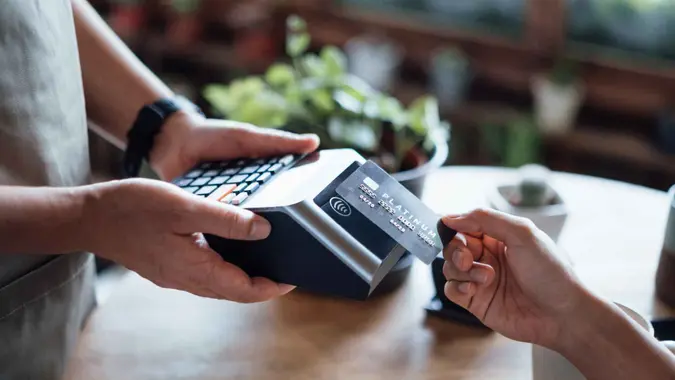What Is the Difference Between a Charge Card and a Credit Card?

Commitment to Our Readers
GOBankingRates' editorial team is committed to bringing you unbiased reviews and information. We use data-driven methodologies to evaluate financial products and services - our reviews and ratings are not influenced by advertisers. You can read more about our editorial guidelines and our products and services review methodology.

20 Years
Helping You Live Richer

Reviewed
by Experts

Trusted by
Millions of Readers
Spending money, whether it is for fun or function, can often add up more quickly than you would prefer. When you don’t have enough money in your bank account to cover the cost of your next purchase, you might need to charge the expense or use your available credit. Though differences can be subtle, it is important to understand which card to swipe and when. Keep reading to learn more about the difference between a charge card and a credit card.
What Is the Difference Between a Charge Card and a Credit Card?
The main differences between charge cards and credit cards are the payment requirements and the interest charged. Though these cards share some similarities, they are not directly interchangeable when it comes to your personal finances. Both have advantages and disadvantages but no matter which you use, monitoring your account balances and bill payment remains vitally important to the overall health of your credit.
Charge Card: Quick Take
Charge cards were the first form of plastic card introduced to the consumer market. They were often issued by retailers for use in their specific stores, and soon became available for wider use. Here are some key takeaways:
- Charge cards very often will not have a monthly spending limit or a limit at all.
- Whatever you spend in a billing cycle must be repaid at the end of the cycle.
- There is no minimum payment you can make because by practice and by definition, charge cards demand that the balance be paid in full at the end of every billing cycle.
- Charge cards do not charge interest on your balance.
- Charge cards work essentially as short-term loans and the balance cannot carry over month to month.
Credit Card: Quick Take
Credit cards are a form of payment that allows you to make purchases and repayments. Though they have many similarities to a charge card here are some key takeaways:
- Credit cards often come with a preset spending limit that varies by individual and card issuer.
- They offer a minimum monthly payment option, so you could conceivably not pay off the total of what you owe for a very long time.
- It requires you to pay interest on your balance, and sometimes this interest rate can be devastatingly high.
- You have the ability to carry a balance from month to month.
- The interest rate can also be raised by the credit card company at will. Many people can’t get out from under their debt because their interest rates just keep adding to their total balance.
- The best way to positively affect your credit score is to pay your balance in full each month on or before the due date.
- Many cards come with an annual fee.
Charge Card vs. Credit Card Breakdown
When comparing a charge card vs. credit card, it helps to know their key features at a glance.
| Charge Card Features | Credit Card Features |
|---|---|
| Often don’t have monthly spending limits | Most have preset spending limits based on individual’s credit |
| No interest charged on your balance | You must pay interest on unpaid balances |
| Balance must be paid in full at end of billing cycle | Have options per billing cycle to partially pay or pay in full |
Final Take To GO
Just about everyone knows what a credit card is, but many people are unaware of what a charge card is, and what the difference is between the two. To add to the confusion, many businesses can use the terms interchangeably, because the “charging” part is the point of both types of card. The primary differences between charge cards vs. credit cards are interest charged on balances and the payment requirements.
FAQ
Here are some answers to frequently asked questions about the differences between charge cards and credit cards.- What is better -- a charge card or a credit card?
- A credit card is better overall for establishing a solid payment and credit history. It is also what is factored into your credit utilization rate or ratio. This is the amount of revolving credit or how much you currently owe divided by your credit limit.
- What is the point of a charge card?
- A charge card is often issued by retailers for use in their specific stores but also is available for wider use. Here are some key takeaways:
- Charge cards usually do not have a monthly spending limit, or a limit at all.
- Whatever you spend in a billing cycle must be repaid at the end of the cycle.
- Charge cards do not charge interest on your balance.
- A charge card is often issued by retailers for use in their specific stores but also is available for wider use. Here are some key takeaways:
- What are the disadvantages of credit cards?
- A big disadvantage of credit cards is the interest you have to pay on your account balance. This makes the overall cost of your purchase more expensive in the long run, and if you don't pay your credit card bill on time, this can not only hurt your credit score but also increase the amount of debt you're in, which can become a vicious cycle.
- What are the disadvantages of charge cards?
- One disadvantage of charge cards is that they only work as short-term loans and the balance cannot carry over month to month, which means no matter what you wrack up in charges on your card, your balance total must be paid at the end of the billing cycle.
- Why use a charge card over a credit card?
- One advantage of a charge card is they don't come with a limit and don't charge interest. Be aware of your balance so it doesn't get away from you as the entire balance will have to be paid each month, or billing cycle.
Chris Chisholm contributed to the reporting for this article.
 Written by
Written by  Edited by
Edited by 
























